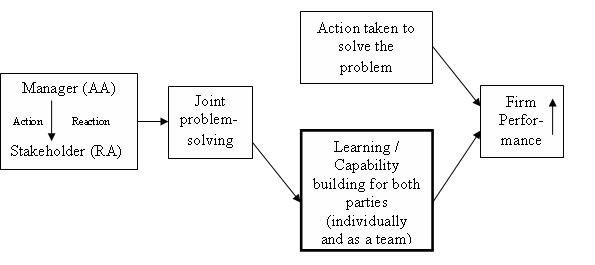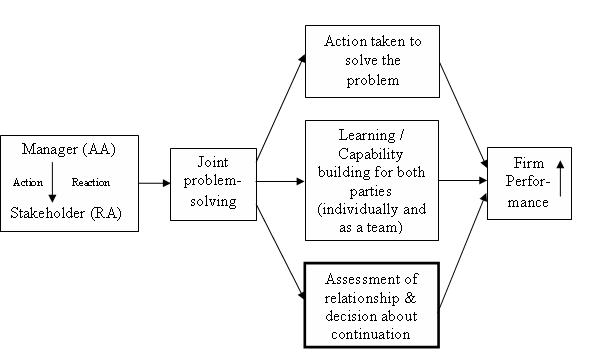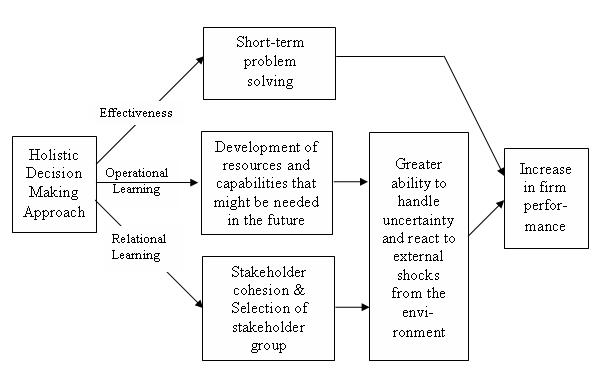
Holistic Decision Making
Holistic decision making encourages us to be aware of our actions and their impact on the whole
Every single minute of human history is marked by decisions that affect every aspect of life, often far from the site of the decision itself. Collectively, these decisions have brought us to where we are today: to an environment marked by economic unpredictability, social instability and environmental degradation. Clearly, it is time to challenge the way in which we make decisions.
Holistic decision making encourages us to be aware of our actions and their impact on the whole; it ensures that we take responsibility and accept accountability for the decisions we make and empowers us to be part of the ongoing process of change. In order to provide managers with the necessary tools to manage modern organizations with a view to building long-term sustainable competitive advantage, it is imperative that organizations embrace a more holistic approach to problem solving.
Organizations consist of multiple stakeholders – both internal and external -- whose actions are coordinated by managers to attain common goals. We define a ‘managerial decision’ as one in which at least one stakeholder is involved, and we base our framework on a positive sum assumption of stakeholder interactions, whereby as long as firms engage in activities that consider the best interests of their stakeholders in their decision-making processes, the symbiotic nature of these relationships ensures that the best interests of all will ultimately be met.
Not all decisions have the same impact on an organization. We make a distinction between technical and managerial decisions. Technical decisions are those that do not directly require the involvement of any stakeholder to be implemented, while a decision that involves even one stakeholder directly is a managerial decision. For example, a managerial decision might require the implementation of a price increase by a subordinate (internal stakeholder), or might involve a customer accepting a price increase.
Until recently, managerial competence was widely accepted to include three elements: knowledge, skills and attitude. But recently, a fourth important element has been added to the list: meta-cognition. Meta-cognition is a higher-order skill that refers to an awareness and monitoring of one’s own cognitive state and that of others. Metacognitive skills include taking conscious control of learning, planning and selecting strategies, monitoring the progress of learning, and changing direction as necessary.
In an environment riddled with complexity and uncertainty, rigorous problem-solving skills have become the foundation upon which long-term performance is built, and meta cognition plays a key role. While a focus on cognitive states has been common in the study of consumer decision-making and behaviour, these same psychological theories and methods are now being applied to the examination of managerial thinking and decision-making.
In addition to the emerging demand for skills in meta-cognition, today’s environment demands two further managerial competencies: the promotion of ongoing learning at all levels of the organization in order to anticipate environmental changes and adapt accordingly; and an ability to foster stakeholder cohesion. In our view, an organization can be said to be operating at ‘optimal capacity’ when it boasts the three following characteristics:
• A strong capacity for problem-solving, including the meta cognition element;
• A strong capacity for learning and developing dynamic capabilities to adapt to the changing environment; and
• A cohesive group of stakeholders.
Holistic decision making takes all three elements into account. We define holistic decision making as a managerial competence by which the decision maker takes into consideration and incorporates two ‘impact dimensions’ when making a decision that involves interactions with at least one stakeholder:
1. Effectiveness
The first impact dimension of a decision is the extent to which it solves the immediate problem that it was meant to solve. As this can be difficult to measure in complex situations, we are more concerned with the ex ante emphasis on problem solving -- the extent to which a manager takes a particular action, which he believes will be sufficient to solve the immediate problem. We call this the executive dimension of a decision.
2. Operative Learning
As a result of having interacted to solve a particular problem, the agents involved have the capacity to learn something. The second impact dimension of a decision is the extent to which it enhances or diminishes the capacity of the two agents, both individually and as a team, to solve similar problems in the future. We refer to this dimension as the operational learning dimension.
3. Relational Learning
Each interaction that a manager has with a stakeholder is an opportunity for the two agents to learn about each other, and the decision taken by the manager and its subsequent implementation will influence the extent to which the two agents will want to work with each other in the future. The third impact dimension of a decision is the extent to which the agents involved in it increase their willingness to work together in the future as a result of having interacted on the decision. We refer to this dimension as the relational learning dimension.
To illustrate the holistic decision-making framework, we will focus on the simplest possible relationship between a focal decision maker, whom we refer to as the Active Agent (AA), and a stakeholder, internal or external to the firm, whom we refer to as the Reactive Agent (RA).
As depicted in Figure One, the Active Agent (AA) faces a problem, such as falling margins due to erosion in prices. To solve it, he decides to initiate an action (A) so that someone else, whom we will call the Reactive Agent (RA), will initiate a reaction (R), so that together, the action and the reaction can solve the problem. The RA in this case might be a subordinate, who is asked to investigate the causes for the price erosion, or a supplier, who is asked to absorb a reduction in prices. In either case, the AA relies on the reaction of the RA for the decision to take its course.
The action and the reaction represent the executive dimension of the decision. If the problem is solved, then the decision and the subsequent action are considered effective; otherwise they are not. In our example, the submission of a report by the subordinate (RA) that allows the AA to arrest the falling margins would lead to the original decision of involving the subordinate being qualified as ‘good’. Similarly, a proposal by the manager (AA) to the supplier (RA) for a price reduction would also be considered a ‘good’ outcome if the latter accepts the proposal.
Clearly, the manager (AA) can involve stakeholders in different ways to solve problems. Let us take the case of the subordinate (RA). The manager could either instruct his subordinate to impose a price reduction on the supplier (directive problem solving), or ask him to investigate the reasons behind the falling margins and propose a solution (open ended problem solving). In the first case, the manager might be successful in arresting the decline in margins, but would have enhanced his subordinate's ability to solve a similar problem in the future only marginally, if at all. In the second case, the subordinate might after the appropriate analysis come up with a solution that does indeed require a price reduction from the supplier, or he might come up with a completely different solution. Whatever solution he comes up with, he would have partaken actively in generating it. The manager might require him to explain his solution, and to improve it by taking additional factors into consideration that might have been overlooked.
Clearly, in the second case, the manager-subordinate interaction is very different from the first one, because there is greater probability that both the manager and the subordinate will learn from the experience of having worked together to solve the problem of margin erosion. They might even learn about each other's strengths and weaknesses. For example, the manager might learn that the subordinate is highly data driven, and that he complements the manager's ‘big picture’ approach. Our point is that by taking into account the operative learning dimension, managers can improve the long-term performance of their firms.
The executive and operative learning dimensions are illustrated in Figure One and Figure Two.
Figure One: The Executive Dimension: Focusing Only on Effectiveness

Figure 2: The Strategic Dimension: Focusing on Operational Learning and Effectiveness

In the above example of the problem of falling margins, the manager might decide that the solution lies in asking a supplier to reduce prices. Again, there are multiple ways in which this can be achieved. The use of power to force a price reduction might resolve the immediate problem, but it would affect the willingness of the supplier to continue to work with the manager and his firm. The manager must therefore ask himself - Is it fair to ask this supplier to reduce prices? Can we offer something in return -- such as higher purchasing quantities per order or higher annual volumes that might partly offset the impact of the price reduction?
Unfortunately, in the majority of cases, decisions are made based only on dimension #1 (how effective they will be in solving a particular problem), without attention paid in any systematic way to the other two critical dimensions.
Figure Three: The Leadership Dimension: Focusing on Effectiveness, Operational Learning and Relational Learning

Ohio State University’s Paul Nutt profiled 78 case studies of managerial decision making and found that most decision processes were ‘solution centered’, which, in his words, seemed to restrict innovation, limit the number of alternatives considered, and perpetuate the use of questionable tactics. According to Nutt, “The bias for action causes [managers] to limit their search, consider too few alternatives, and pay too little attention to people who are affected, not realizing that decisions fail for just these reasons. Managers want to find out what is wrong and fix it quickly, and the all-too-frequent result is a hasty problem definition that proves to be misleading.”
Stanford’s James March and Nobel Laureate Herbert Simon have also identified this problem and described the common motivation to use bland alternatives, stating that perceived time pressure begins to mount as decision-making reaches the idea stage, often creating artificial pressure to adopt the first workable idea that is uncovered.
As defined earlier, the executive dimension of a decision maker is her capacity to solve problems and execute her immediate plans flawlessly. Though such a capacity is basically positive, it can lead to failures if the two other dimensions are not considered. Nutt confirmed this through his studies: “When the direction set by a manager rapidly narrows, or displaces a solution, little learning can occur”; and “When managers impose an answer, they create a misleading clarity that sweeps aside important sources of ambiguity and uncertainty.”
In this context it becomes clear that a possible exchange with the relevant stakeholder might have led to a better decision than the immediate focus on the problem’s solution. As a result, Nutt found that virtually half of the decisions in organizations fail. His study of 356 decisions in medium-to-large organizations in the U.S. and Canada revealed that these failures can be traced to managers who impose solutions, limit the search for alternatives, and use power to implement their plans. In a recent article, he pointed out that decision makers typically seek to act swiftly, whereas only one in ten decisions actually requires urgent action, and only one in a hundred necessitates crisis management.
In closing
We have identified three dimensions that every manager must take into account during decision deliberation. By considering the two learning dimensions of our decision making framework in addition to the commonly-considered effectiveness dimension, a firm can increase its capability-and knowledge-building competencies and promote stakeholder cohesion.
It is important to note that a holistic approach does not by any means provide easy answers. If anything, it highlights the fact that decisions are fraught with complexity. For this reason, we view decision making as a managerial competence that requires deep knowledge of specific products, markets and industries; finely honed skills in managing interpersonal relationships, effective communications, and negotiations; and the right attitude based on professionalism, integrity, and a genuine interest in the development of all stakeholders.
Holistic Decision Making
 Our thesis has clear implications for managers on the one hand, and for management educators on the other. Most importantly, it constitutes advice for managers on how to manage their stakeholder relationships. By taking the three decision-impact dimensions into account, managers can immediately begin to enhance the quality of their decision making. And educators can also begin to integrate stakeholder issues into their curriculum by encouraging students to focus on the operative and relational learning dimensions of their decisions.
Our thesis has clear implications for managers on the one hand, and for management educators on the other. Most importantly, it constitutes advice for managers on how to manage their stakeholder relationships. By taking the three decision-impact dimensions into account, managers can immediately begin to enhance the quality of their decision making. And educators can also begin to integrate stakeholder issues into their curriculum by encouraging students to focus on the operative and relational learning dimensions of their decisions.[This article has been reprinted, with permission, from Rotman Management, the magazine of the University of Toronto's Rotman School of Management]
Post Your Comment















